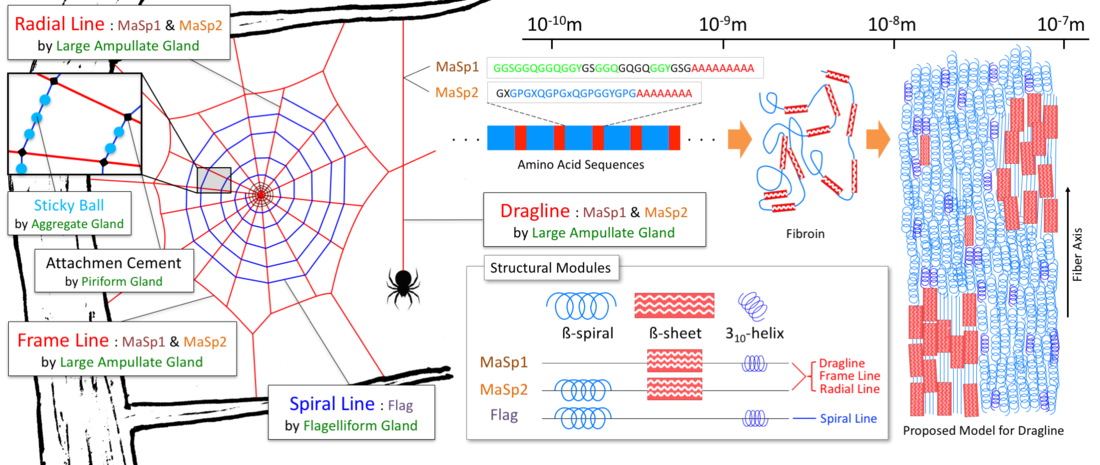Huge spider glue genes proved exceptionally challenging to sequence, could lead to organic pest control and more.

Researchers have determined the first-ever complete sequences of two spider glue genes. University of Maryland Baltimore county postdoctoral fellow Sarah Stellwagen at the Army Research Lab has discovered the first-ever complete sequence of not one, but two genes that allow spiders to create their webs. These gene sequences allow spiders to produce a modified version of spider silk that keeps spiders' prey stuck to their webs. By discovering this gene, researchers are one step closer to understanding and hopefully creating new biosynthetic materials.
Over the years, spider silk has been one of the hottest topics in synthetic chemistry. Mimicking a spider's natural silk and being able to create it on a commercial use could change the way almost every industry operates. A new biodegradable, incredibly strong, and eco-friendly material that can be woven, hardened, and used for all types of suspensive purposes.
With over 45,000 known spiders in the world, there are 7 different silk types with all different kinds of tensile strengths and flexibilities. As important as the discovery of new biosynthetic material is, only about 20 genes of a spider's silk has been analyzed. Stellwagen claims that scientists have been able to recreate a liquid similar to that of spider silk inside of a spider's body, but are unable to replicate the process. By creating a "spider glue" Stellwagen is hoping to create some sort of organic pest control.

Stellwagen sees great potential for spider glue applications. She states that, "This stuff evolved to capture insect prey". Farmers could spray the glue along a farm wall to protect their livestock from insects that bite or transmit diseases. Then, they could wash it away and have no ecological effects.
While sequencing the gene, Stellwagen was surprised at how colossal the gene actually was. The gene had been anticipated at approximately 20,000 base pairs. However, when Stellwagena and her team delved deeper into the complex structure of the spider's genes, they really ended up with approximately 42,000 base pairs. Not only was the code difficult to crack, but there was much repetition within the code. The amino acids alanine and glycine make up many of the building blocks of a spider's silk chemical makeup and the team would often lose the place where they were analyzing. Stellwagen and her team are hopeful to create a synthetic version of a spider's spinnerette to cut their web "glue" and create synthetic spider silk.
I believe Stellwagen and her team are making tremendous progress towards synthetic silk. I'm extremely excited to see where other researchers will take this as well. By identifying these key genes and proteins, hopefully, a collaboration between Stellwagen and other teams of researchers will be able to understand how spider spinnerettes work, and be able to create mechanical ones. I'd love to see more research on the Australian Golden Orb spider because of its tensile strength, size, and silk makeup.
Synthetic spider silk could be revolutionary in both fields of engineering and pest control. Since silk is stronger than steel, the buildings and bridges we make could be more resilient and take up less space. It's amazing to learn that the code for spider silk is made of almost 42,000 base pairs, but I would not expect anything less from such a strong material. I like how you also noted the means of evolution for silk. Since they evolved to capture insects, it makes perfect sense to spray spider glue in farms to protect animals. It seems like a much better alternative to chemical pesticides. Kudos to Stellwagen and the research team for being able to crack the code! I am not the biggest fan of spiders, but I appreciate them much more now.
ReplyDeleteSynthetic spider silk has a lot of potential as it is an incredibly strong material. The problem right now is that spider silk costs roughly $15,000 per pound. However, as we know learn more about the spiders genome a method could be developed to force spiders into over expressing this gene, allowing for the practice of silk farming and decreased price, which could give spider silk a wide variety of applications. It's amazing how spider's have evolved to produce silk this strong. Very cool!
ReplyDeleteI remember learning about the strength of spider silk from watching Spider Man. It is amazing how an animal so small can create something so strong. If spider silk was able to be manufactured on a larger scale, there is no end to the applications we could find for it. I think the use for a pest control is a good place to start. I think it is kind of funny to use the silk of a spider who some consider a pest to control other pests. This article adds to the growing list of advantages that come with the existence of spiders, despite how scary they look.
ReplyDelete